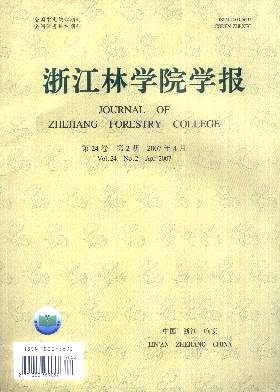| [1] |
XU Bin, WANG Hengxu, LU Jie, FU Shenyuan, DAI Jinfeng.
Preparation and performance evaluation of bamboo scrimber/glass fiber/PET foam multilayer structural insulated panel
. Journal of Zhejiang A&F University,
2021, 38(2): 396-402.
doi: 10.11833/j.issn.2095-0756.20200330
|
| [2] |
WANG Kunlun, JIANG Ting, HOU Xiaofei, MA Ruijie, WANG Qiuhua, LI Shiyou.
Combustibility of fresh leaves of 17 species of garden bamboo in Kunming
. Journal of Zhejiang A&F University,
2020, 37(5): 963-970.
doi: 10.11833/j.issn.2095-0756.20190612
|
| [3] |
QIAN Yuting, XUE Xiaofeng, ZENG Yanru, CHEN Wenchong, YE Xiaoming, YU Weiwu, DAI Wensheng.
Leaf structure and chlorophyll content in Torreya grandis 'Merrillii' with Nalepella abiesis infestation
. Journal of Zhejiang A&F University,
2020, 37(2): 296-302.
doi: 10.11833/j.issn.2095-0756.2020.02.014
|
| [4] |
YE Xiaoming, QIAN Yuting, YE Wen, SHEN Huangying, ZENG Yanru, YU Weiwu, DAI Wensheng.
Biological characteristics and species identification of Chlorella sp. with Torreya grandis 'Merrillii'
. Journal of Zhejiang A&F University,
2019, 36(4): 629-637.
doi: 10.11833/j.issn.2095-0756.2019.04.001
|
| [5] |
ZHOU Zhen, WANG Chong, HUANG Weidong, ZHANG Qian, WANG Xingmin, LI Yizhen, YI Jianying, LIU Zhiling.
Pest risk analysis of Marumba dyras from Jiangmen City, Guangdong Province
. Journal of Zhejiang A&F University,
2019, 36(1): 206-210.
doi: 10.11833/j.issn.2095-0756.2019.01.026
|
| [6] |
YUAN Xiaolong, LI Juan, LI Yunqin, WANG Yi.
Gene cloning of a PKS/NRPS gene with an SDR domain
. Journal of Zhejiang A&F University,
2019, 36(6): 1247-1253.
doi: 10.11833/j.issn.2095-0756.2019.06.024
|
| [7] |
ZHENG Yongbo, ZHANG Yuyao, LIAO Zhouyu, LI Luliang, ZHOU Jinfeng, WANG Qiuhua, LI Shiyou.
Combustion characteristics of stems and leaves of Eupatorium adenophorum
. Journal of Zhejiang A&F University,
2014, 31(3): 450-456.
doi: 10.11833/j.issn.2095-0756.2014.03.019
|
| [8] |
LI Xiaoping, WU Zhangkang, ZOU Quan, ZHANG Qingwei.
Flammability of particleboard paneling using resins and fire retardants
. Journal of Zhejiang A&F University,
2014, 31(5): 739-744.
doi: 10.11833/j.issn.2095-0756.2014.05.012
|
| [9] |
ZHAN Weijun, LUO Youbo, ZHANG Libin.
Biological and virulence study of highly pathogenic Beauveria bassiana on pine sawyer Monochamus alternatus
. Journal of Zhejiang A&F University,
2013, 30(1): 83-89.
doi: 10.11833/j.issn.2095-0756.2013.01.012
|
| [10] |
LIANG Xiang-mei.
Morphorlogy and biology on Tenthredo nubipennis
. Journal of Zhejiang A&F University,
2012, 29(3): 431-434.
doi: 10.11833/j.issn.2095-0756.2012.03.017
|
| [11] |
YAN Zheng-liang, LIU Yun-cai, HU Guang-hui, LIU Yong-gang, MENG Meng.
Primary insect pest occurrence and tree diversity in stands of Pinus kesiya var. langbianensis
. Journal of Zhejiang A&F University,
2012, 29(2): 226-231.
doi: 10.11833/j.issn.2095-0756.2012.02.012
|
| [12] |
ZENG Fei-li, BEN Ai-ling3, ZHENG Jing-rong, HAN Zheng-min.
Identification and pathogenicity of bacterial strains carried by American pine wood nematodes
. Journal of Zhejiang A&F University,
2012, 29(5): 696-702.
doi: 10.11833/j.issn.2095-0756.2012.05.010
|
| [13] |
YUE Chao-yang, LIU Ai-hua, ZHANG Xin-ping, MA Pei-pei, JIAO Shu-ping.
Poplar resistance to Melampsora rostrupii rust in Xinjiang
. Journal of Zhejiang A&F University,
2011, 28(2): 262-268.
doi: 10.11833/j.issn.2095-0756.2011.02.015
|
| [14] |
XU Hua-chao, HAO Xiao-dong, HUANG Jun-hao, YE Tan-xian, YE Li-xin.
Insects diversity of Fengyangshan Mountain in Zhejiang Province
. Journal of Zhejiang A&F University,
2011, 28(1): 1-6.
doi: 10.11833/j.issn.2095-0756.2011.01.001
|
| [15] |
XIN Xiao-ying, JIANG Hong, ZHOU Guo-mo, YU Shu-quan, WANG Yong-he.
Canadian forest fire weather index (FWI) system:a review
. Journal of Zhejiang A&F University,
2011, 28(2): 314-318.
doi: 10.11833/j.issn.2095-0756.2011.02.023
|
| [16] |
LI Shi-you, LUO Wen-biao, SHU Qing-tai, MA Chang-le, MA Ai-li, ZHANG Qiao-rong.
Combustibility of 25 woody plants for selection of fire-resistant tree species in Kunming area
. Journal of Zhejiang A&F University,
2009, 26(3): 351-357.
|
| [17] |
SHEN You-lian, LAO Chong, FENG Lin-guo.
Biological characteristics and control of Opogona sacchari in Cixi City, Zhejiang Province
. Journal of Zhejiang A&F University,
2008, 25(3): 367-370.
|
| [18] |
HE Qiu-ju, YI Chuan-hui.
Life cycle and pest management of Mictiopsis curvipes
. Journal of Zhejiang A&F University,
2008, 25(3): 363-366.
|
| [19] |
LOU Xiong-wei, FANG Lu-ming, XU Ai-jun, YE Xiang-gen.
Data fusion with 3D modeling for forest fire prevention background database
. Journal of Zhejiang A&F University,
2008, 25(4): 405-410.
|
| [20] |
HUGuo-liang, CHENG Yi-peng, LOUJun-fang, WANG Guo-du, XIAGuo-hua, CHEN Jian-gang, ZHANG Zu-ping.
Biological characteristics of blossom midge(Contarinia sp.) in Carya cathayensis and its control techniques
. Journal of Zhejiang A&F University,
2007, 24(4): 463-467.
|









 DownLoad:
DownLoad: